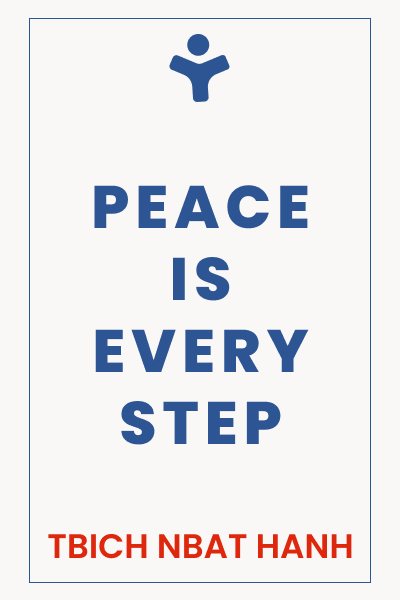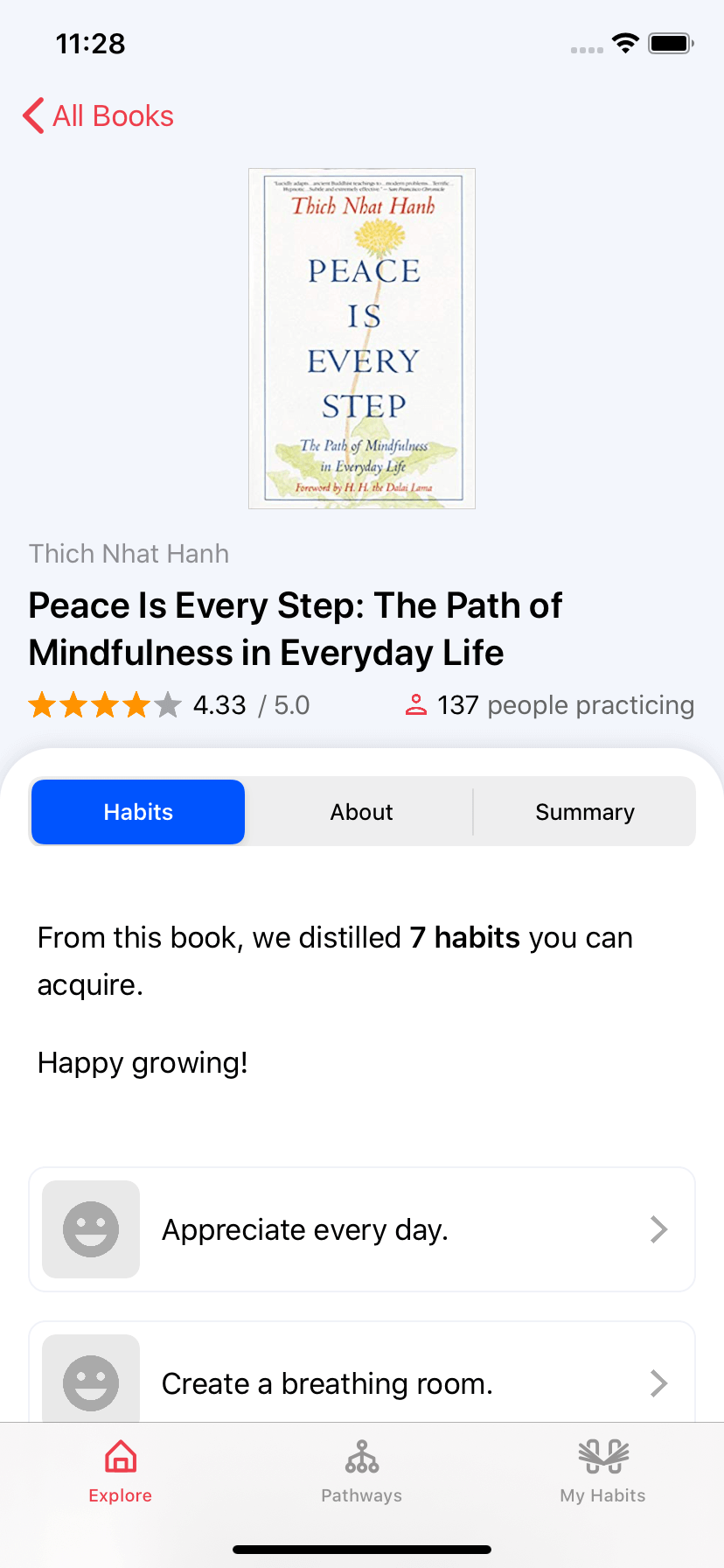
Peace Is Every Step: The Path of Mindfulness in Everyday Life
by Thich Nhat HanhStressful situations are unavoidable in life, but Peace is Every Step can help you approach these situations with mindfulness and positivity to ensure that the stress doesn’t affect your physical and mental well-being. This book will help you access the peace and happiness within you by showing you how to stay in and appreciate the present moment.
We have compiled the advice in this book into a series of habits and actions you can try out from the comfort of your own home! Try even one or two—you’ll notice an immediate positive change in your mood and, over time, your life!
Breathing and Scything/Aimlessness
“I found that if I coordinated the movement of my arms with the rhythm of my breathing and worked unhurriedly while maintaining awareness of my activity, I was able to work for a longer period of time. When I didn’t do this, I became tired in just ten minutes.”
When you cut grass with a scythe, you have to pay careful attention to the way you hold the instrument, the angle of the blade on the grass, and the way you stand. You have to coordinate the movement of your arms with the rhythm of your breathing and be aware of the activity you are performing.
These are all acts of mindfulness; they will help you complete your task without getting tired or losing your breath. Applying these acts of mindfulness to all your tasks will help you achieve similar results.
What’s more, when you begin to practice mindfulness at all times, you will also discover happiness. Think about it this way: When you do not have a toothache, you are not aware of the happiness of a non-toothache. But when you practice mindfulness, you will be aware of your non-toothache and thus be happy. Remember, when you practice mindfulness in the present moment, you are working toward happiness and peace in the future.
Actions to take
Our Life Is a Work of Art
Pragmatism, or looking at things with the intention of getting something, has become a habit of many people. The good news is that there is one best way to stop this habit. That is, through mindfulness—the practice of pausing for a moment and looking deeply into something to understand it.
For example, an artist may look at a flower and begin thinking about how they can paint it in the most beautiful way. This is pragmatism. If the artist practices mindfulness, they will not need to think about how to paint the flower—they will be able to stop, look at the flower deeply, and naturally paint it, and it will be a beautiful painting.
Your life is a work of art. When you practice mindfulness and act with awareness and integrity, your art will flower beautifully, and you’ll be able to serve the world more positively.
Actions to take
Hope as an Obstacle
“Western civilization places so much emphasis on hope that we sacrifice the present moment. Hope is for the future. It cannot help us discover joy, peace, or enlightenment in the present moment.”
Hope can help you make the present moment less difficult to bear. However, this is all hope can do for you. Clinging to hope for the future will keep you from living mindfully in the present; when you refrain from hope, you allow yourself to discover the joy in the present.
Remember that hope is simply not enough to help you reach happiness, as your happiness is already here in the present moment—you just have to allow yourself to discover it. The good news is that there are many things you can try to achieve it.
One of them is creating your own breathing room, where you simply have to decorate your room to your liking. Then, use this breathing room to unwind and destress whenever you need to—such as when you’re feeling overwhelmed or at times when you just want to be alone. Here, you can practice conscious breathing and smile, especially in your most difficult moments. Basically, this is a room of peace where you can withdraw to rest and recuperate whenever you need to.
Another way to be happier is to change your mindset from a negative to a positive one. Oftentimes, when there is a problem in our lives, we face it with a negative mindset—often by trying to pin the blame on someone or complaining about our misery. However, neither of these things will help you resolve the problem, and your negativity will only make you feel worse. Instead, adopt a more positive mindset and look for solutions to your problems.
Aside from switching to a more positive mindset, we can also transform our feelings from negative to more positive ones. This can be done by first acknowledging your negative feelings, becoming one with them, calming them, and finally releasing and looking deeply into these feelings to understand them. By doing this, you’ll be able to nourish your mind positively and begin to understand your feelings more clearly and objectively. What’s more, you may even learn something new about yourself!
The last step you may take to achieve greater happiness is to build a strong foundation for your interpersonal relationships by giving mutual respect. Sometimes, especially when we are feeling strong emotions, it may be difficult to respond with this respect. Fortunately, there is a way to do this, which, when executed properly, can lead to more harmonious relationships.
Actions to take
Interbeing
The word “interbeing” is not in the dictionary yet, but it is a combination of the prefix “inter-” and the verb “to be.” It refers to how everything in this world is connected: For a piece of paper to exist, we need a tree, and for the tree to grow, we need rain, and for the rain to happen, we need clouds, and so on.
Similarly, we cannot just be by ourselves alone. We have to ‘inter-be’ with every other thing in the world. We have to accept the good and the bad in the world, for it is all interconnected, and one cannot exist without the other.
That being said, we should start viewing each other as brothers and sisters, reconcile with our enemies and follow these 14 percepts of the Order of Interbeing:
- Do not blindly follow any doctrine, theology, or ideology. All systems of thought are only guidelines, not the absolute truth.
- Do not think your knowledge now is changeless and the absolute truth. Instead, be open to learning new things.
- Do not force anyone to adopt your views. Instead, help others eliminate fanaticism and insularity through compassionate conversations.
- Do not close your eyes to suffering. Be aware of the existence of suffering and find ways to be by the side of those who suffer.
- Refrain from accumulating wealth while millions are hungry. Live simply and help those in need.
- Do not maintain anger or hatred. When you feel these emotions, focus on your breathing until they pass.
- Place your focus on the present moment. Do not get distracted by your surroundings.
- Avoid saying hurtful words. Instead, make every effort to reconcile and resolve conflicts.
- Do not lie. Always tell the truth and give only constructive criticisms. Be courageous enough to speak out against injustices, even if it means jeopardizing your safety.
- Do not use a religious community for personal gain or profit. You must only stand against injustice and oppression and work to improve things without participating in partisanship.
- Do not live with a vocation that is harmful to humans and nature. Choose a vocation that promotes meaning and compassion.
- Do not kill, and do your best to prevent others from killing. You must always protect life at all costs.
- Do not possess the property of others. Respect their property, but do not allow them to profit from human suffering or the suffering of others.
- Do not mistreat your body nor view it as just an instrument. Instead, treat it with high respect. Avoid sexually expressing yourself without love and commitment.
Following these 14 precepts will help you live your life with mindfulness and compassion and will promote inner peace.
Actions to take
Don’t just read. Act.


